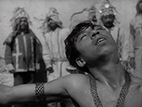Sergei Eisenstein's Mexican Footage - excerpts - Sergei Eisenstein
- Unseen Cinema Collection |
- 1930-1932 |
- 10 minutes |
- B&W |
- SILENT
Rental Format(s): Digital File
"Dance of the Heads" and "Day of the Dead" - 2 excerpts from original camera rolls
Co-makers: Sergei Eisenstein, Grigori Alexandrov, and Edward Tisse
Original format: 35mm silent film 1.33:1
Silent as found
Courtesy: Gosfilmofond of Russia
Eisenstein's ill-fated trip to Hollywood and Mexico influenced many Americans approach to avant-garde cinema. Of all the beautiful images captured by Eisenstein in Mexico, some of the most fascinating involve dance. The first shots portray dancers in ecstasy; the Day of the Dead images shows human and machine movements. -Bruce Posner
Eisenstein intended to make a film symphony, a film serape or Diego Rivera Mural of the seventh art. 'I wanted to show a timeless Mexico where the past was merged with the present'; but the shooting stopped abruptly because the funding was cut, and although they promised to send the material, never received it and he died without being able to conclude with his own hands one of his great works. -Oswaldo Betancourt
Sergei Mikhailovich Eisenstein's (1898-1948) name is synonymous with 20th century avant-garde art. The Russian genius created films and film theories based upon an "intellectual montage" created through a synthesis of cinematography, editing, and later, sound recordings and music. Throughout the world, advanced filmgoers eagerly awaited his films and writings. His influence upon '20s and '30s American cinema was unprecedented, serving as inspiration for amateurs and professionals alike. In 1930, he traveled to the U.S., and then Mexico, in an unsuccessful attempt to make a film. His presence in the Americas stimulated much debate within experimental film circles. -Bruce Posner
Grigori Alexandrov (1903-1983) "A prominent Soviet film director initially associated with Sergei Eisenstein, with whom he worked as a co-director, screenwriter and actor. Their final collaboration together was on the unfinished film Que Viva Mexico! Alexandrov became a major director in his own right in the 1930s with a string of musical comedies starring his wife Lyubov Orlova." -Wikipedia
One of the greatest cameramen of 20th century cinema, Eduard Tissé (1897-1961) worked closely with Soviet director Sergei Eisenstein during a 20-year period. Along with Eisenstein and Grigori Alexandrov, he travelled across Europe and the United States, eventually filming in Mexico for the unfinished epic Que Viva Mexico!. -Bruce Posner







